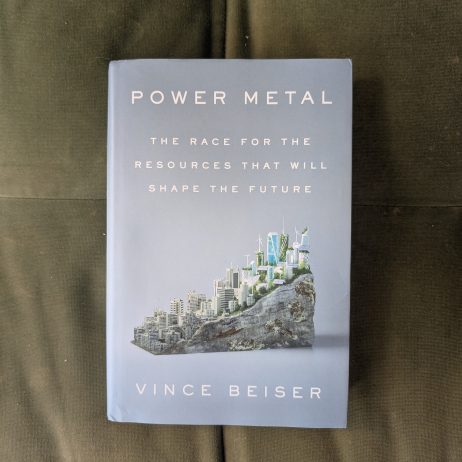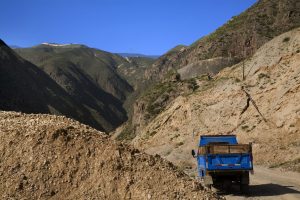The world, journalist Vince Beiser says, is moving into the “Electro-Digital Age” and at the heart of this new era is a set of ancient, naturally occurring minerals: metals. The critical metals necessary to run the modern world and, importantly, required to power the energy transition away from fossil fuels also produce extraordinary consequences for humanity and the planet.
In “Power Metal: The Race for the Resources That Will Shape the Future,” Beiser charts a court across the world to understand how these metals are moved from the earth to our technology, and the competition that has arisen around them.
 Just think about how you are reading this interview: Either on a computer or your phone, powered by an electric grid and batteries. Your phone alone is packed with minute amounts of dozens of different metals ripped from the earth from places as distant as the Democratic Republic of the Congo, Indonesia, and Chile; though much of it, Beiser notes, eventually travels through China.
Just think about how you are reading this interview: Either on a computer or your phone, powered by an electric grid and batteries. Your phone alone is packed with minute amounts of dozens of different metals ripped from the earth from places as distant as the Democratic Republic of the Congo, Indonesia, and Chile; though much of it, Beiser notes, eventually travels through China.
“China has, in recent decades, come to dominate the supply chains for every single one of the metals and finished products we need for the Electro-Digital Age.”
In the following interview with The Diplomat’s Managing Editor Catherine Putz, Beiser explains the “Electro-Digital Age,” how critical metals fuel conflicts in Asia, and the facade of “clean” or “green” technology. Everything, he says, has a cost. Understanding and accepting that fact is necessary to minimize the damage we do to our planet.
You characterize our present age as the “Electro-Digital Age.” What are the defining features of this age?
There are three major, interconnected drivers of the Electro-Digital Age: digital technology and the internet; renewable energy; and electric vehicles. These forces are changing how we power our civilization, communicate with each other, travel from place to place, and generally live our lives on an increasingly stressed planet.
Digital tech, of course, is already deeply embedded in our lives and only growing more essential to almost everything we do. Renewably-generated electricity and electric vehicles are both coming on fast. In many ways, that’s great. The energy transition from fossil fuels to renewables is a crucial part of the cure for climate change. But it’s a cure with brutal side effects. Taken together, the three pillars of the Electro-Digital Age are inflicting tremendous but largely overlooked harm on people and the planet. That’s largely because all three pillars of this new, high-tech era depend on a set of ancient, natural materials: metals.
Lithium, cobalt, nickel and several other “critical metals” are used to build not only electric cars, but also the hardware of renewable energy: solar panels, wind turbines and the electric grid itself. Many of those same critical metals are also in our digital gadgets, from iPhones to Xboxes. To meet the surging demand for those metals, rainforests are being cut to the ground. Rivers are being poisoned. Children are being put to work in mines. Warlords are getting rich. And untold numbers of people are getting killed.
How important is China in terms of critical metals – from mining to processing to the production of final goods?
It’s hard to overstate China’s importance in this arena. By leveraging its own natural resources, relatively lax environmental standards, diplomatic clout, and shrewd overseas investments, China has, in recent decades, come to dominate the supply chains for every single one of the metals and finished products we need for the Electro-Digital Age.
China has huge domestic reserves of many metals (some of which, by the way, it allegedly mines with forced labor). The resources it lacks at home, it buys abroad; Chinese companies own mines all around the world that produce raw cobalt, nickel, and many other metals. Regardless of where critical metals are dug up, or by whom, most will end up sent to China for refining and processing. Finally, Chinese factories put those refined metals to use on an unmatched scale. China produces more solar panels, wind turbines, lithium-ion batteries, and electric vehicles than any other nation.
All of which gives Beijing not only major economic power, but also enormous geopolitical clout. And they have shown they are willing to use it. In 2010, China and Japan got into a spat over their territorial waters. To punish Japan, China cut off exports of rare earths, a set of metals crucial to Japan’s consumer electronics industry. The move sent shockwaves around the world. It was sort of the opening shot in the global struggle for critical metals, the moment when Western policy makers and corporate executives suddenly realized how vulnerable they were, how much leverage Beijing has over them. China could unsheathe the embargo weapon again at any time.
When looking at Asia, in particular, how are critical metals intertwined with regional conflicts, such as in Myanmar?
In October, in a remote, mountainous corner of Myanmar, a local rebel group seized a small piece of territory from a pro-government militia. That minor military victory has important implications for the world, because that territory in Kachin state is an important source of rare earth metals that are crucial components of electric car motors and wind turbines.
Kachin is full of rare earth mines. The main mining area had been controlled by a militia allied with Myanmar’s military junta government. That militia had been doing a booming business selling rare earths to China. In 2014, Myanmar exported just $1.5 million worth of the metals to China. That figure has since rocketed into the billions of dollars.
Those rare earths come at a bitter cost. Government-aligned militias have seized lands at gunpoint from the Indigenous Kachin people. To extract the rare earths, miners drill holes into mountainsides and inject them with an ammonium sulfate solution that liquefies the earth, which drains into chemical-saturated collection pools. The process has spread toxins into the country’s soil and rivers, and also causes landslides. Just last June, a landslide at a rare earth mine in the Kachin region killed at least ten people.
Ethnic rebels with the Kachin Independence Army have been fighting for their land and autonomy since the junta took power in 2021. As the combat drew closer to the mining zone, workers fled and China was obliged to halt rare earth imports. Now that the rebels have taken the mining area, they could go into the rare earths business themselves, but that will take a while. In the meantime the chaos is likely to cause rare earth supply shortfalls. And if the fighting picks up again, the mines could be offline indefinitely, throwing a new obstacle into the path of the energy transition.
Myanmar isn’t the only such place. New Caledonia has been wracked with periodic spasms of violence as the Indigenous Kanak people have battled with descendants of European settlers over profits from the country’s vast nickel deposits. In the Philippines, protests against nickel mines have been forcefully broken up. Further afield, militias have battled in the Democratic Republic of the Congo for control of cobalt mines.
One of the throughlines of the book as you explore the life cycle of critical metals – from mining, to various recycling and reuse avenues – is what you refer to as the “inescapable principle”: that “nothing comes without a cost.” Can you describe, in brief, the range and variety of costs associated with critical metals?
Digging up metals typically involves destroying the Earth in the most literal sense. The whole object is to tear up trees or grasslands or deserts, blast apart the underlying rock and earth with explosives, and rip out the remains. In Indonesia, to choose one especially shocking example, the nickel industry has torn up more than 290 square miles of tropical forest in recent years.
Once in operation, metal mines devour titanic quantities of energy and water. Often, chemical leaks and runoff foul the surrounding air and water. And it doesn’t stop there. The metal-bearing ore clawed out of the ground has to be processed, smelted, and refined with enormous, energy-guzzling, pollution-spewing industrial equipment and oceans of chemicals.
All of which often translates into serious health hazards for people living nearby. (Not to mention those forced from their homes to make way for mines.) Irate local residents and Indigenous communities are fighting proposed critical metal mines in many countries, including the Philippines and Indonesia. In some places, this kind of opposition can have lethal consequences. At least 320 anti-mining activists around the world have been murdered since 2012. Critical metal industries can even be dangerous for the people working in them. In recent years, dozens of workers have died in accidents at a giant Indonesian nickel refining complex.
A related question: Are green technologies really all that green?
If you ask me, there’s no such thing as “green technology” or “clean energy.” Like I said before: Everything has a cost. To be clear, we do need to switch to renewable energy and electric cars. Those things are much easier on the planet, on balance, than their fossil-fuel powered counterparts. They are critical parts of the cure for climate change. But they are cures with side effects.
You highlight consumption reduction – especially in regard to automobiles – as one of the best ways to reduce the harms of our collective and constant use of critical metals and energy. To what extent should this reduction come on the back of government regulation? Is personal responsibility enough?
It’s great when people decide to switch to using a bicycle or public transit instead of owning a car. But as individuals we can’t do nearly enough. Modern cities, which is where most people live, are designed for cars. It’s often unsafe and/or wildly impractical to get around in them on foot, on bike, or by transit. That has to be changed at a systemic level; we need to make it easy and safe for people to get around without needing a car. That requires government involvement. Governments are already heavily involved in promoting car use, after all. Every paved road that was paid for with taxes is a government-subsidized piece of infrastructure for cars. Why shouldn’t governments start using some of those resources instead to build bike lanes, mass transit, and walkable neighborhoods?
In the current conversations about critical metals and the energy transition, what do you think gets missed or misunderstood the most?
I think one major issue is that too many people expect perfect solutions. Solar and wind power and electric vehicles are often seen as unmitigatedly good things – virtuous products used by virtuous people. It’s certainly true that they are necessary to help stave off climate change, the biggest threat of all. And they are generally easier on the planet than coal, oil, and internal combustion cars. But they don’t “help” the Earth. They have costs of their own. They cause their own forms of damage. That’s a depressing reality we have to accept and understand– and then do everything we can to keep that damage to a minimum.

































